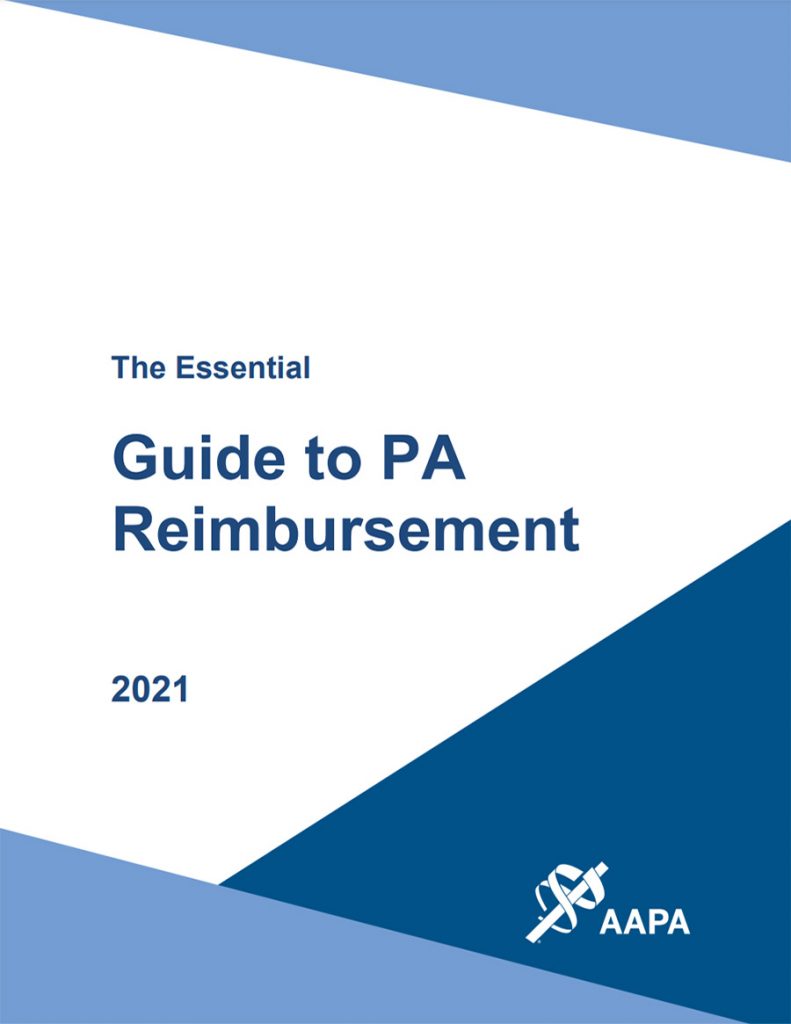Learn About Significant Policy Changes in 2021 Essential Guide to PA Reimbursement
Updates Reflect Important Changes Over the Past Year
March 15, 2021
 Many significant policy changes to PA practice occurred over the past year, and AAPA is providing updated information about those changes in the 2021 edition of the Essential Guide to PA Reimbursement, now available for purchase. Among the topics that have been added or updated are:
Many significant policy changes to PA practice occurred over the past year, and AAPA is providing updated information about those changes in the 2021 edition of the Essential Guide to PA Reimbursement, now available for purchase. Among the topics that have been added or updated are:
- Direct payment for PAs: Explores the January 2022 change to PA Medicare reimbursement policy: who it will most affect and how it will change stipulations for PA practice ownership
- Home Health: Reflects the significant shift in policy that permits PAs to certify need and establish and review the plan of care for home health
- Diagnostic Tests: Reflects changes that authorize PAs to supervise certain diagnostic tests performed by ancillary staff
- Medicare and Federal Response to Public Health Emergencies: Delves into the federal response to COVID-19 under the public health emergency and the many temporary authorizations that came about as a result
- Open Payments Program: Discusses the addition of PAs to the financial relationship disclosure program and what it means for PAs
The Essential Guide to PA Reimbursement is updated annually to provide PAs and other stakeholders a detailed summary and explanation of the key aspects of coverage and regulatory policies related to reimbursement for medical and surgical services delivered by PAs. It contains nearly 100 pages of description, analysis, and implications of reimbursement policy affecting PAs in all settings, as well as more than 300 pages of appendices compiled into a perfect tool for reference and research, and a comprehensive glossary of reimbursement terms.
The 2021 edition includes important reimbursement policy changes related to the COVID-19 Public Health Emergency. In response to the COVID-19 pandemic, CMS authorized numerous regulatory changes and flexibilities over the past year to increase patient access to care and protect both patients and healthcare professionals. Some of these regulatory relief measures were identified as temporary, lasting only through the duration of the public health emergency. However, as the COVID-19 crisis accentuated the importance of America’s healthcare workforce being able to practice to the full extent of their education and experience, several of the policies increasing PA practice flexibility were implemented on a permanent basis.
The Essential Guide to Reimbursement summarizes changes to policies pertaining to PAs that were established through 1135 Waivers (which allow the temporary relaxation of regulations to provide flexibilities under Medicare, Medicaid, CHIP, and HIPPA), interim final rules released in response to the public health emergency, the Public Readiness and Emergency Preparedness (or PREP) Act (used to provide immunity from liability related to the development, manufacturing, testing, distribution, administration or use of countermeasures detailed in a Prep Act Declaration), the Coronavirus AID, Relief, and Economic Security (or CARES) Act, the Coronavirus Relief & Budget Omnibus Act, and the 2021 Physician Fee Schedule Final Rule. These legislative and regulatory actions made significant changes to the ways in which PAs may practice in both the short and long term. Through these laws, rules, and waivers, the federal government has demonstrated a willingness and ability to adapt policies to meet the changing needs of patients in our healthcare delivery system and made significant progress in enhancing the efficiency and effectiveness of PAs.
In a rapidly changing healthcare environment, a thorough understanding of the PA payment policies of public and private payers is essential for demonstrating PA value, maximizing the collection of appropriate reimbursement, and avoiding concerns about fraud and abuse. The Essential Guide to PA Reimbursement includes information on:
- Requirements for participation in the Medicare program
- The PA-physician relationship under Medicare
- Office billing, including an explanation of “incident to”
- Hospital billing, including an explanation of Shared Visit
- Nursing facilities
- The Quality Payment Program
- Coverage issues
- Medicaid
- Commercial Payers
- Electronic Health Records
- And much more!
The Essential Guide to PA Reimbursement is provided in PDF format at the member price of $25 and non-member price of $125. Purchase the Essential Guide online in AAPA’s store.
Contact [email protected] for more information.
You May Also Like
Utah PA Shares Experience Facing Outdated Laws and Red Tape
PAs Secure Strengthened PA Practice and Expanded Patient CARE Under Medicare in 2020
PA State Chapters Persevere in 2020 to Achieve Improvements for Profession
Thank you for reading AAPA’s News Central
You have 2 articles left this month. Create a free account to read more stories, or become a member for more access to exclusive benefits! Already have an account? Log in.



